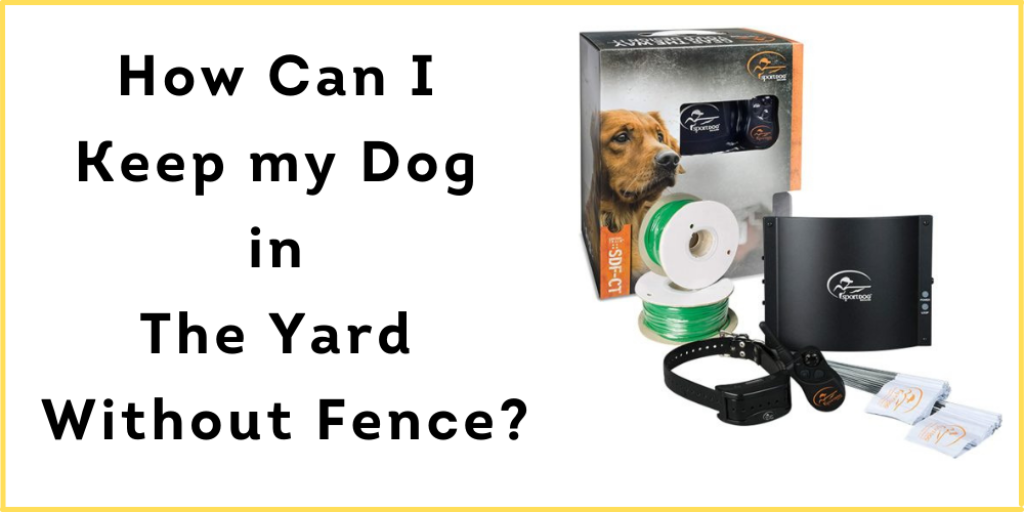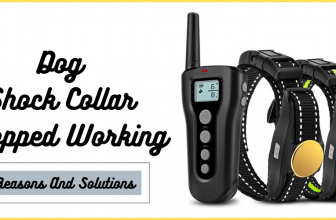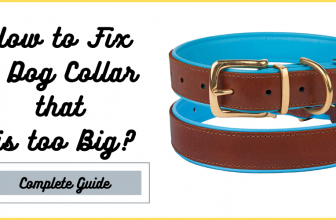For a dog lover and owner that did not have a fence, one of the challenges is keeping or making your dog stay in the yard. You want to give your pet the freedom and happiness they deserve but at the same time, you also want to keep them from getting hurt, dog-napped, or hurting the neighbors. The easiest way to do this is by having a fence. But in the case of no fence, other alternatives could be considered.
Keeping your dog safely in a yard is a dream come true for dog owners without a fence. Because it provides peace of mind, such that your dog can do its morning walks alone, do its tinkle alone and chase squirrels but not into your neighbor’s yard. What a relief, right?
Contents
How Can I Keep my Dog in The Yard Without Fence?
Well, if you have been thinking about how to keep your dog in the yard alone, you do not have to anymore because we are here to help you with that. So, now let’s look at ways you can keep your dog in the yard without a fence.
1. Create Boundary
Having a boundary is one step to making your dog stay in the yard. This could be done with the use of flags, poles, or any proper material of your choice. Since you do not or cannot afford to build a fence, these materials can stand in to mark the boundaries of your yard.
When trained properly, your dog can come to identify these materials as its boundary, and sometimes without training, your dog can subconsciously come to learn this. Though it will take your dog a very long time to familiarize yourself with the boundary.
Related Guide: Do Electric Fences Work for Big Dogs?
2. Boundary Training
Although this is one of the most time-demanding ways to keep your dog in the yard, it is an inexpensive and effective alternative to building a fence. It is also simple. All you have to do is to train your dog to never leave the yard.
After you must have created a boundary with maybe a flag or any of the materials you choose, you do not just sit and expect your pet not to walk past the boundary. You have to train it to recognize that its territory starts from a particular point to another point as indicated by the flags or the boundary you choose. This even makes it easier to train your dog.
Now training your pooch can be done through different approaches as far as it works for your dog. But just a heads up! This requires effort, hard work, and patience.
3. Consider Using an Invisible Dog Fence
An invisible fence? Sounds quite mysterious, right? Well yeah, it is a fence all right but not the type that stands tall some meters away from your door. It is a device that issues a mild static shock to your dog whenever it goes outside its boundary. The system is engineered with a GPS signal that monitors the movements of your dog and helps you to know their whereabouts. This way is very effective and saves more than building a physical fence.
The static shock delivered to the dog is very mild, just enough to alert your dog of overstepping and so does not cause severe pain. Despite that, some dog owners still do not like the idea of the static shock delivered by the invisible fence because they feel it is inconsiderate to punish or instill fear in living things. But when you compare the safety of your pet to the mild static shock, you would go for the invisible fence.
4. Employ the Use of Tie-out Systems
A tie-out or tethered system involves the use of a rope or chain to keep your dog within a particular area. This rope or chain is tied to a pole or tree or even permanently staked down into the ground.
The rope after being tied should be long enough to afford your dog the space they need to move freely around the yard just within the boundary. It is important to note that the tie-out method might not be the best to be used in the backyard because your pet might get entangled or trapped with the ropes. So you should use it where you can easily see your pet.
5. Long Lines
Long lines still involve the use of a rope or chain or leash long enough to allow your pet the freedom it needs. It is almost like a tie-out system but this time the rope is attached to you.
Though this method depends on your presence, you can just sit down while reading a magazine without having to worry or constantly look up to see what’s happening with your dog.
Options for Keeping a Dog in the Yard
If you do not want to try any of the aforementioned ways, there is one more option you could try.
Exercise Pen: An exercise pen is a small temporary enclosure that allows your dog to at least stretch its legs. It is an enclosed space so your dog cannot walk outside the walls of the pen. To make it more fun for your dog, you can put in toys, playthings, and most of all a lot of water.
This option is most suitable for a small dog. It works better for a small dog because since it is a small space, your small dog is most likely to maximize the space and feel freer than a big dog.
Why Does my Dog Keep Running Out of the Yard?
Dogs can be very restless and playful. Some can be very curious too. They do not mind chasing a squirrel into your neighbor’s yard and even up a tree. They want to chase after butterflies or just run around. Whatever it is, there are a lot of reasons why your dog keeps running out of the yard.
It could be lonely or even bored. This is especially if your dog is an active breed. Dogs like that need to be in action now and then to be happy. They are always on the lookout for fun stuff to do and if that is not in your yard, they will run out of the yard to look for it.
If your dog keeps running out of the yard after you have trained it to stick to the boundaries, then something is wrong. Now, it is one thing to “train your dog to stay” in its boundary and it is another to “make it stay” in its boundary. You don’t just train your dog to stick to the boundary and leave it at that. Make the boundary fun, add toys, play stuff, have playtime with your pet and lots of water in the yard so it does not go sniffing around for water.
Conclusion:
There is nothing as good as having a dog that understands its owner. It makes giving instructions very easy. Through instructions, boundary training is made easier. Although giving instructions require your presence, you can also leave your yard and trust your dog to stay within its boundary. You can use words like stay, leave, stop, etc. These words are short and easier for them to understand.
One good thing about instructions is that your dog will obey but not for long so if you are going to be absent, make it short. You should not stay away for long. Following any of the ways mentioned above, keeps your dog safe in the yard and reduces every chance of it getting hurt, hurting people, or even getting dog-napped. Now that you know all these, I wish you luck with whatever way you choose to employ.








